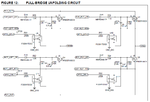Ashvinpambhar
Newbie level 5
Hi,
I used a controller dsPIC33FJ16GS504 for on gird solar-microinverter, in my hardware part when I applied input (24-dc battery not a solar panel), also connect lamp of 300 W as a load, and applied a grid to the output side as per given in document (for detail microchip document AN1444).
I also read a procedure to start hardware. As per procedure first step connect grid and load then start power on switch which is connected between battery and input.
My question is that when I start a power on switch after completing a procedure as per above, a part of hardware known as a full bridge unfolding circuit (attached with this post and also available on document AN1444 page no 11) has a four MOSFET (IPB60R190C6) in which only right top MOSFET is burn out after some time (1 to 2 minutes) and remaining three has no effect like that. So my problem is why only one MOSFET (top-right) is burn out not other and what is the solution for that. (for detail circuit description given in document AN1444).

I used a controller dsPIC33FJ16GS504 for on gird solar-microinverter, in my hardware part when I applied input (24-dc battery not a solar panel), also connect lamp of 300 W as a load, and applied a grid to the output side as per given in document (for detail microchip document AN1444).
I also read a procedure to start hardware. As per procedure first step connect grid and load then start power on switch which is connected between battery and input.
My question is that when I start a power on switch after completing a procedure as per above, a part of hardware known as a full bridge unfolding circuit (attached with this post and also available on document AN1444 page no 11) has a four MOSFET (IPB60R190C6) in which only right top MOSFET is burn out after some time (1 to 2 minutes) and remaining three has no effect like that. So my problem is why only one MOSFET (top-right) is burn out not other and what is the solution for that. (for detail circuit description given in document AN1444).
